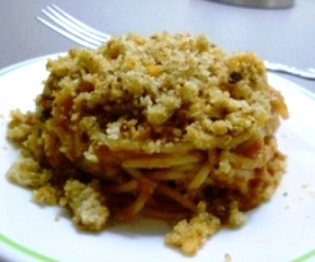Food Studies features the voices of 11 volunteer student bloggers from a variety of different food- and agriculture-related programs at universities around the world. You can explore the full series here.
 I have always had a fascination with the idea of a food memory — a Proustian time capsule accessed through the smell and taste of a particular food. Sometimes just hearing the name of a dish can be enough to remind you exactly how it tastes and feels in your mouth, and can bring back the many associations you have with it.
I have always had a fascination with the idea of a food memory — a Proustian time capsule accessed through the smell and taste of a particular food. Sometimes just hearing the name of a dish can be enough to remind you exactly how it tastes and feels in your mouth, and can bring back the many associations you have with it.
My grandmother used to make a dish called, simply enough, spaghetti and breadcrumbs. As the name implies, she would toss spaghetti in a tomato sauce, pour it into a casserole dish, and top it with breadcrumbs. She’d add a little bit of butter here and there (well, more like a lot of butter) and then bake it until the top was golden brown. The result was what is perhaps one of the simplest yet most delicious pasta dishes, in my opinion, to ever have been introduced to human taste buds.
Growing up, I was a pretty picky eater, but this was a dish I wanted quite frequently. With my grandmother living in Florida and me in New Jersey, I would ask my mother time and time again to replicate the dish. My grandmother, of course, didn’t have any sort of written-down recipe, leaving my poor mother to take down vague directions from her over the phone. I ended up so frustrated by my mother’s mock spaghetti and breadcrumbs that I stopped wanting the dish.
Years later, as I was becoming more enamored with food, and, at the same time, getting into chemistry in high school, I began trying to work out the elusive spaghetti and breadcrumbs recipe myself. I realized relatively quickly that the key ingredient was the canned sauce, and I conducted trial after trial until I finally found the flavor I was looking for. I knew it, too, as soon as I cracked open the can of that particular sauce. The smell of the dish baking in the oven, the cracking sound of the toasted breadcrumbs as my grandmother would scoop out a serving, and the experience of being in her kitchen, watching her cook, all came back to me in a rush.
It was then that I realized how important ingredients are, how important recipe formulation is, and how key it is to have the ability to replicate a recipe over and over again — to recreate the same exact product every time.
Now that I’m a junior at Rutgers University and a food science major, I’m learning to think and understand at a chemical and biological level what food is, as well as how it is affected by processing and packaging. As many science professors have told me, the real validity of any experiment lies in the ability for anyone else, with no other information in front of them than the lab protocol, to be able to replicate the experiment and reach the exact same results. Recipe formulation relies on exactly the same concept. Food manufacturers can — and must — ensure that, whether a customer buys their product a week from now, a month from now, or a year from now, they will be purchasing the exact same product. That fact is the result of a scientific approach of dealing with food. In turn, it creates product loyalty — and more importantly — food memories.
Over this fall, I will continue to broaden my scientific background, taking courses in microbiology, physics, and psychology and applying them to courses in food science as well as research in a sensory laboratory. I look forward to sharing my growing comprehension of the science behind food, and my appreciation of its usefulness. Meanwhile, though, here’s a piece of advice: next time you’re eating a delicious home cooked dish that you can’t imaging not being able to eat for the rest of your life, be sure to get the recipe — and if none exists, start working on developing one right away.



